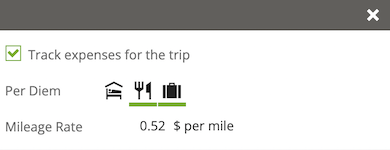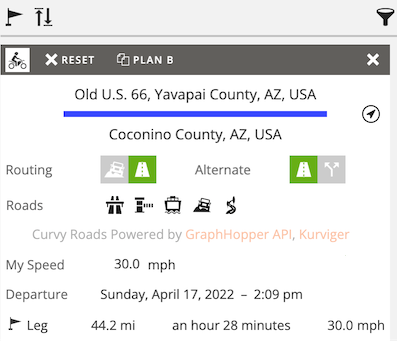Plan with Furkot buttons
August 1, 2015
You can add plan with Furkot button to any website or blog promoting or describing a place. It works great with websites for restaurants, hotels, roadside attractions, museums, shops - the typical locations that people visit while traveling. By adding plan with Furkot button you make it easy for travelers to add your place to their trip itinerary increasing the chances of turning viewers of your website into visitors to your place.
While we use plan with Furkot labels for the buttons, you can name them however you want and style them in a way consistent with your website look-and-feel.
When clicked, Plan with Furkot buttons direct visitors to the Furkot website which guides them through the process of adding stops to their trip itineraries. Alternatively Plan with Furkot buttons can be configured to facilitate adding stops to users' trip itineraries directly on your website by embedding Furkot trip planner widget.
We offer several ways of adding plan with Furkot to your web pages. If your website already uses microdata, we have a script that you can use to add plan with Furkot buttons automatically. In case there is no suitable structure data you can always add plan with Furkot buttons directly to the HTML markup.
By placing plan with Furkot buttons on your website you provide your visitors a trip planning functionality. That's not the only benefit you can derive from plan with Furkot buttons. You can also make money - we offer a revenue sharing program - once visitors start adding places from your website to their trips you can receive a share of revenue we earn from these trips for booking hotels, flights and car rentals.
Microdata
If the web page is annotated with microdata adding plan with Furkot buttons is as easy as adding a script element.
The script above finds items with geographical coordinates of the type http://schema.org/GeoCoordinates and appends plan with Furkot button to each item. The button is created as an anchor element <a> with text set to Plan trip to followed by the item name as defined by itemprop value name.
href value of the plan with Furkot button determines properties of the stop added to trip when the button is clicked. In addition to coordinates it encodes item properties of following itemprop values: name, address, description. url of the stop is set to the url of the webpage containing plan with Furkot button and stop icon is based on the itemtype of the item.
Anchor elements representing plan with Furkot buttons have class furkot-plan that can be used to style them in a way consistent with your website look-and-feel.
If the page already contains anchor elements with class furkot-plan and no href attribute they are used instead of creating new ones. This way you can decide where plan with Furkot buttons are placed and what should they display instead of default placement and text.
If you are adding plan with Furkot buttons in order to integrate Furkot trip planner widget, you don't need to include the script above; use data-source="microdata" option instead.
The script furkot-plan-microdata.min.js is an open source project; you can check it out and contribute to it on github.
See the example below of microdata annotations and a default plan with Furkot button added by the script.
Click the live link to see example of how plan with Furkot button works: Plan trip to Bourbon House.
HTML Markup
At the minimum plan with Furkot buttons need geographical coordinates of your place and its name. Additionally you can specify url, description and recommended duration of the visit. Depending on your preference you can add plan with Furkot button using either an anchor element or a form button.
When creating an anchor element, you'll need to encode place specifics into the query part of href attribute. In case of a form button place specifics need to be broken down into hidden input elements. Following parameters are supported:
stop[name]- place name; mandatorystop[coordinates][lat]- latitude of the place; mandatorystop[coordinates][lon]- longitude of the place; mandatorystop[address]- place address as comma-delimited string; optionalstop[url]- place url, typically the url of the page to which plan with Furkot button is added; optionalstop[notes]- place description up to 256 characters; optionalstop[pin]- icon representing the place, from the list of Furkot icons; optionalstop[duration]- suggested visit duration in milliseconds or as a string formatted as described here; optionalstop[route][polyline]- route leading to the stop - format compatible with Google polyline encoding algorithm; optional (mandatory if any other route attribute is present)stop[route][duration]- route duration in seconds; optionalstop[route][distance]- route distance in meters; optionalstop[route][mode]- travel mode (car, motorcycle, bicycle, walk, other); optionaluid- the unique identifier obtained when registering online to join the Furkot revenue sharing program; optional
The example below creates both anchor and form button for the Okemo Resort.
Click the live link and the button below to see example of how it works:
Visit Okemo Resort on your trip
Use CSS to style the button in a way consistent with your website design.
Multiple stops
The plan with Furkot button can be configured to add multiple stops to a trip with a single click. Use parameter stops with an index instead of stop when encoding place attributes.
Click the live link to see example of the plan with Furkot button adding multiple stops to a trip: Add 2 stops to Furkot trip.
Visit duration
Recommended duration of a visit can be specified as duration attribute. The value is expected to be either expressed in milliseconds or as a string with number of nights, hours and minutes.
Following modifiers are used for:
n- nightsh- hoursm- minutes
To add an overnight stop, specify its duration as one night: 1n or 86400000 milliseconds.
To spend two and a half hours at a stop specify its duration as 2h30m or 9000000 millisconds.
Five-day stop with an extra hour on the last day (to account for checkout or cleaning up): 5n1h or 435600000 milliseconds.
Value of the duration attribute determines how Furkot will schedule it in user's trip itinerary. If it is less than 24 hours and doesn't specify any nights it is treated as a duration of a visit to the place to be scheduled during day time. If it exceeds 24 hours it's divided by 24 hours to calculate number of night to spend at a place with the reminder determining the departure time on the last day. Specifying number of nights explicitly with the n modifier has the same effect.
Routes
Each stop may have a route leading to it. The route is specified as polyline attribute encoded according to Google polyline encoding algorithm. If your website is using Google Maps JavaScript API, you can use google.maps.geometry.encoding.encodePath to encode polyline for the route. There are also compatible implementations of the algorithm available, for instance jieter/Leaflet.encoded or mapbox/polyline.
When the plan with Furkot button is configured with more than one stop, it is assumed that the route parameters of the stop describe route from the preceding stop.
Route can optionally specify a travel mode attribute as one of the following values: car, motorcycle, bicycle, walk, other.
The plan with Furkot button with a single stop with route will add a route linking 2 stops to the trip: one at the beginning of the route and the other - the one specified - a the end.
Click the live link to see example of the plan with Furkot button adding a route to a trip: Add route to Furkot trip.
When you want to specify name and other attributes of the stop at the beginning of the route configure plan with Furkot button to add multiple stops and list the stop at the beginning of the route before the stop with the route.
Click the live link to see example of the plan with Furkot button adding a route between stops to a trip: Add route between stops to Furkot trip.
Javascript
If you prefer to use Javascript, you can use convenience functions from our furkot-trip library to encode stop parameters into links to Furkot. Check out the detailed description on github.
When adding stops to a trip furkot-trip library redirects user to the Furkot website. If you are integrating Furkot trip planner widget, use trip-planner library instead. It exposes similar interface but activates Furkot trip planner widget embedded in the page to add stops to a trip.
Revenue sharing program
When you register online to join the Furkot revenue sharing program, you are issued the unique identifier. Make sure you specify its value as the uid parameter in the query part of href attribute of the anchor element or the hidden input element of the form. This is what we need to credit you with your share of revenue from reservations made by users who added stops to their trips by means of plan with Furkot buttons.
You don't have to include uid parameter if you are adding plan with Furkot buttons in order to integrate Furkot trip planner widget; use data-uid option of the widget instead.


